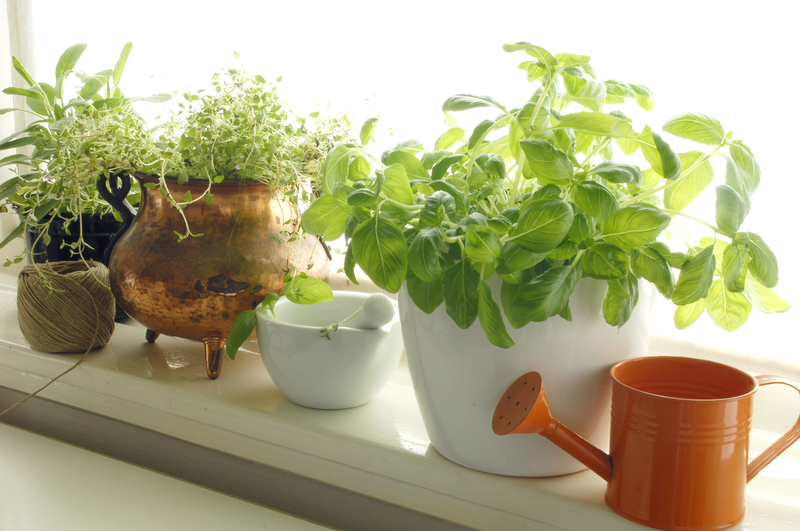Eco-friendly landscapes with vertical gardening
Posted on 04/06/2025
Eco-Friendly Landscapes with Vertical Gardening: A Comprehensive Guide
In an era where urban spaces are shrinking and the need for sustainable living is ever-increasing, eco-friendly landscapes have emerged as a beacon of hope. Among the most innovative approaches to creating verdant spaces in limited environments is vertical gardening. Embracing vertical garden designs not only enhances the aesthetics of homes and workplaces but also contributes positively to the environment.

What is Vertical Gardening?
Vertical gardening refers to the technique of growing plants on vertical surfaces, such as walls, fences, or specially designed structures. These gardens can range from small installations of potted plants on shelves to elaborate living walls that span entire facades. This method is particularly appealing in urban areas where ground space is precious.
- Living walls: Panels of plants that grow vertically using hydroponics or soil.
- Green facades: Climbing plants rooted at ground level which grow up walls.
- Modular vertical planters: Stacked or wall-mounted containers designed for easy maintenance.
Benefits of Eco-Friendly Vertical Gardening
Environmental Advantages
Adopting eco-friendly landscapes through vertical gardening presents numerous environmental benefits:
- Enhanced Air Quality: Plants naturally filter toxins from the air, reducing pollution and supplying oxygen.
- Urban Heat Island Mitigation: Green walls can "cool" buildings, lowering overall urban temperatures.
- Rainwater Management: Vegetation absorbs rainwater, reducing runoff and filtering pollutants.
- Biodiversity Promotion: Vertical gardens welcome pollinators such as birds and insects back into city environments.
Aesthetic and Psychological Benefits
- Beautification: Vertical gardens transform bland walls and fences into vibrant living tapestries.
- Well-being Boost: Studies show interaction with greenery relieves stress and boosts productivity.
- Noise Reduction: Thick living walls can absorb sound, providing natural acoustic insulation.
Key Elements of an Eco-Friendly Vertical Landscape
Transforming any vertical space into a green oasis requires careful planning and the use of sustainable materials. Below are the main elements to consider when designing and implementing a vertical garden for improved sustainability:
Choosing Sustainable Plant Species
- Native plants: Select species well-adapted to local climate and soil, requiring less water and maintenance.
- Drought-tolerant varieties: Opt for succulents, ferns, and air plants to minimize water use.
- Edible plants: Incorporate herbs, vegetables, and fruits to double your wall as a source of healthy produce.
Sustainable Structures and Materials
- Recycled containers: Use upcycled materials like pallets, plastic bottles, or wooden crates for planters.
- Bamboo and FSC-certified wood: These provide sturdy, renewable support structures.
- Non-toxic paints and finishes: Ensure no chemicals leach into the plants or surrounding environment.
Water Conservation Techniques
- Drip irrigation systems: Deliver water directly to plant roots, minimizing waste.
- Rainwater harvesting: Collect and reuse rainwater for irrigation.
- Mulching: Apply organic mulch to containers to retain moisture and suppress weeds.
How to Start Vertical Gardening for an Eco-Friendly Landscape
Embarking on your vertical gardening journey requires strategic planning. Here are step-by-step instructions to help you design an eco-friendly vertical landscape, from concept to completion:
1. Analyze Your Space
- Evaluate wall exposure to sunlight, wind, and rain.
- Check wall load-bearing capacity, especially for large installations.
- Measure dimensions to plan your green layout efficiently.
2. Select the Right Structure
- Choose structures appropriate for your chosen wall or fence: trellises, modular pockets, custom-built frames, or lattices.
- Opt for sustainable, durable materials as previously mentioned.
3. Plan for Smart Irrigation
- Install a drip irrigation or capillary system for water efficiency.
- Integrate rainwater storage solutions where possible.
- Set timers or moisture sensors to optimize watering cycles.
4. Choose Plants That Thrive Vertically
- Group plants with similar light, water, and nutrient requirements.
- For beginners, try low-maintenance species like pothos, spider plants, philodendrons, or sempervivum.
5. Prepare the Growing Medium
- Use lightweight, nutrient-rich soil or hydroponic setups, depending on design.
- Add organic compost for sustainable nutrient cycling.
6. Install and Plant
- Secure framework and containers firmly to the wall or supporting structure.
- Plant from the bottom up for easier access and improved growth establishment.
7. Maintain for Longevity
- Regularly prune overgrowth and monitor for pests or diseases.
- Fertilize occasionally with organic compost tea or seaweed extract for optimal health.
- Refresh soil annually and rotate crops if growing edibles.
By following these steps, you can create your own eco-friendly vertical landscape that thrives, benefits the planet, and uplifts the spirit.
Vertical Gardens in Urban Spaces
Eco-friendly vertical gardening is revolutionizing cities worldwide, bringing pockets of nature into metropolis cores. Here's how vertical gardens are reshaping urban living:
Community Initiatives and Urban Farming
- Green corridors: Vertical gardens along public walkways and transit lines increase green cover.
- Urban farms: Companies and municipalities are employing living walls for large-scale agriculture in city centers.
- Community engagement: Rooftop and wall-mounted edible gardens foster shared stewardship and local food production.
Eco-Friendly Architecture and Building Design
- Energy efficiency: Living walls insulate buildings, reducing heating and cooling needs.
- Rainwater utilization: Integration of rainwater capture systems for garden irrigation.
- LEED certification: Vertical gardens help buildings achieve green building certifications.
Creative Ideas for Eco-Conscious Vertical Landscapes
Imagination and sustainability go hand-in-hand when creating vertical gardens. Consider these eco-friendly vertical garden ideas for inspiring your next project:
- Upcycled shoe organizers: Hang fabric shoe organizers and fill pockets with herbs and flowers for a rustic, low-cost vertical garden.
- Pallet gardens: Repurpose old wooden pallets as modular, wall-mounted planting beds.
- Self-watering moss walls: Use preserved moss with built-in irrigation for lush greenery with minimal care.
- Living privacy screens: Train vining plants like ivy or honeysuckle up trellises for green privacy partitions on patios or balconies.
- Recycled bottle gardens: Cut and hang plastic bottles horizontally to create linear planters along fences or walls.
Challenges and Solutions in Eco-Friendly Vertical Gardening
Like any innovative approach, sustainable vertical landscaping comes with its set of challenges. However, with mindful planning and modern technology, these issues are surmountable.
Common Challenges
- Structural load: Ensuring walls and supports can bear the weight of saturated soil and mature plants.
- Water management: Avoiding waterlogging or uneven irrigation.
- Plant selection: Matching species to microclimates and light levels.
- Maintenance: Reaching upper levels for pruning, pest control, and replanting.
Effective Solutions
- Consult professionals: For large or commercial installations, work with structural engineers and horticulturists.
- Modular systems: Use interchangeable planting modules for easier plant replacement and maintenance.
- Smart sensors: Integrate soil moisture, light, and nutrient sensors with automated systems.
- Accessible design: Incorporate hinged or pull-down frames for easy access to higher sections.

Eco-Friendly Vertical Garden Maintenance Tips
A thriving eco-friendly landscape demands regular but eco-conscious care. Follow these tips to ensure your vertical garden remains lush and sustainable:
- Inspect irrigation frequently: Prevent leaks and ensure even watering to all levels.
- Promote biodiversity: Rotate crops, plant a mix of species, and avoid monocultures.
- Use natural pest control: Deploy beneficial insects, neem oil, or soap sprays instead of chemical pesticides.
- Harvest responsibly: Pick edible plants regularly to encourage new growth and prevent overcrowding.
- Monitor soil health: Add organic matter and check for compaction or nutrient deficiencies.
The Future of Eco-Friendly Landscaping with Vertical Gardening
As cities grow denser and climate challenges loom, eco-friendly vertical landscapes will become indispensable in sustainable urban development. Advancements in living wall technology, plant biotechnology, and smart irrigation will keep evolving, making green vertical spaces more accessible and affordable for all.
Embracing vertical gardening is not just about aesthetics or space-saving. It's a forward-thinking choice that fosters biodiversity, improves quality of life, and actively combats environmental challenges.
It's time to look up - and start gardening upwards.

